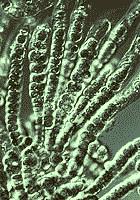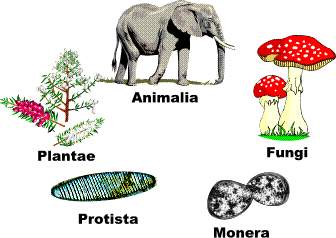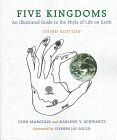
Domain Archaea
(formerly "Archaeobacteria")

Domain Eubacteria

Domain Eukarya
| "Tellurobiota" - Life on Earth |
||
| Life on Earth | Kingdoms of Life |
| Life on Earth | Life | Master | |
| Astrobiology | Bacteria | Master | Mind |

|
Abbreviated Dendrogram Life ("Tellurobiota")
│
└─Bacteria (Crown Group Life)
├─Eubacteria
└─┬─Archaea
└─Eukarya
├─Chlorobionta
└─┬─Fungi
└─Metazoa
├─Deuterostomia (incl. Vertebrata)
└─Protostomia
|
Life |
Up until the 1950s and 60s, textbooks only referred to two kingdoms of living beings, Animals (including protozoa) and Plants (including bacteria). These are the same two suggested by Linnaeus, and retained by some occultist systems of thought, such as Theosophy and Anthroposophy, and unified systems of science and metaphysics like those of Arthur Young and Edward Haskell, all of whom added inanimate (e.g. mineral) and - in the case of the theosophists non-physical ("elemental") kingdoms on, giving all of them the same grade as Animals and Plants.
Now, on the macroscopic level it is quite easy to see the distinction between a plant and an animal. A plant sits in one place and makes glucose from sunlight, carbon dioxide and water, whereas an animal roves about and needs to find its food outside of itself. But on a microscopic level this situation breaks down. Not only are there single-celled organisms that sometimes act like plants and sometimes like animals (Euglena for example photosynthesis food from sunlight but also can feed by consuming organic matter like an animal). Then there are bacteria and blue-green algae, which differ structurally from higher organisms far more than plants differ from animals. A paradigm shift was required. This culminated in the Five Kingdoms hypothesis.

graphic from the former "Five Kingdoms page"
The progress of scientific knowledge has meant the increasing divergence of science from metaphysics, and in 1959 R. H. Whittaker replaced the unwieldy dichotomy of plant and animal kingdoms: animals, plants, Fungi, Protista or Protoctista, and Monera (bacteria and blue-green algae, with only a very simple, prokaryote, cellular structure). The five kingdom paradigm was further developed by Lynn Margulis. This very useful system is still retained in many text books today. But it has recently been shown to be inadequate (e.g. the tremendous metabolic and structural diversity of Monera and Protista, and the fact that those two taxa are paraphyletic and not viable under the modern cladistic scheme). Hence the (currently preferred) "three domain" model.

Modern genetic research over the last decade or so has revealed that anaerobic bacteria found in harsh oxygen-free conditions are genetically and metabolically completely different from other, oxygen-breathing organisms. These bacteria, called Archaeobacteria, or simply Archaea, are said to be "living fossils" that have survived since the planet's very early ages, before the Earth's atmosphere even had free oxygen. DNA and RNA analysis have suggested to some workers that, instead of five kingdoms, there are actually three "Domains": Archaea, Bacteria, and Eukarya (Eukaryota). This last group refers to organisms whose genetic material is contained in a special membrane, the nucleus, and includes all higher organisms from protists to humans. Rather than just four kingdoms it would seem to include over a dozen. So much so that the term "Kingdom" has become (in this usage) meaningless. So we have:
| two kingdoms | five kingdoms | three domains and who knows how many "kingdoms" | |
| Animalia (all Metazoans) | Animalia | Eukarya | Animalia |
| Plantae | Fungi | Fungi | |
| Plantae | Plantae | ||
| either Protozoa (=Animal) or Algae (=Plant) | Protoctista | Alveolata | |
| Stramenopiles | |||
| etc... | |||
| Sporozoa | |||
| Mycetozoa | |||
| Euglenozoa | |||
| etc... | |||
| Archezoa | |||
| Plant (bacteria and blue-green algae) | Monera | Eubacteria | (kingdoms not specified) |
| Archaea | Euryarchaeota Korarchaeota Crenarchaeota |
||
Thus the diversity of life is seen to be far more complex than was envisaged, and familiar organisms like animals and plants are just a tiny proportion of all of the many different forms.
The following diagram illustrates the relationship between the Three Domains, and the various branches of each.
 Domain Archaea (formerly "Archaeobacteria") |
 Domain Eubacteria |
 Domain Eukarya |
We follow -- to the extent possible -- a cladistic model without fixed ranks. However cladograms, with their continual bifurcations, do not lend themselves to the kind of ranked hierarchical structures necessary to keep a web site organized. Accordingly, we have adopted a modified five-kingdom model for organizational purposes. Actually we use six categories, as follows:
Bacteria: This section covers both the the Eubacteria and Archaea.
Eukarya: This section covers almost exclusively single-celled forms, i.e. the Protista or Protoctista. For historical reasons, the basal Plantae and red algae (Rhodophyta) are also in this group.
Plants: It might be more accurate to call this section Chlorobionta. As mentioned, the clade Plantae is a bit more inclusive and also includes Rhodophyta and certain "green algae" which are treated in the Eukarya section.
Fungi: As we define Fungi, this section probably ought to include the Microsporidia. It doesn't. Other than the Microsporidia, this section covers the Fungi.
Invertebrates: Here we take up all metazoans except the chordates.
Vertebrates: Finally, the largest single section of Palaeos covers the chordates, with about 99% of this material devoted to the Vertebrata.
University of California Museum of Paleontology -- The Biosphere: Life on Earth - Three Domains of Life
![]() The Tree of Life Project Root Page - The Tree of Life project adopts the three domain model.
The Tree of Life Project Root Page - The Tree of Life project adopts the three domain model.
Natural History - General - Phylogeny
Classification of the Earth's Biosphere - by W B Leatham - an interpretation of high order systematics, incorporating recent discoveries of new taxa into a modified Linnean hierarchy (replacing "Domain" with "Superkingdom"). Also provides a useful summary of each phylum of organism, together with known geological time range.
| Life on Earth |
(Life) | Page & (prokaryotes) |